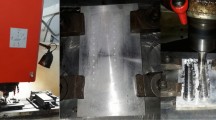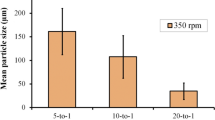Abstract
In the present study, SiC nanoparticles were added to as-cast AZ91 magnesium alloy through friction stir processing (FSP) and an AZ91/SiC surface nanocomposite layer was produced. A relation between the FSP parameters and grain size and hardness of nanocomposite using artificial neural network (ANN) was established. Experimental results showed that distribution of nanoparticles in the stirred zone (SZ) was not uniform and SZ was divided into two regions. In the ANN modeling, the inputs included traverse speed, rotational speed, and region types. Outputs were hardness and grain size. The model can be used to predict hardness and grain size as functions of rotational and traverse speeds and region types. To check the adequacy of the ANN model, the linear regression analyses were carried out to compute the correlation coefficients. The calculated results were in good agreement with experimental data. Additionally, a sensitivity analysis was conducted to determine the parametric impact on the model outputs.
Similar content being viewed by others
References
Liao J, Yamamoto N, Nakata K (2009) Effect of dispersed intermetallic particles on microstructural evolution in the friction stir weld of a fine-grained magnesium alloy. Metall Mater Trans A 40:2212–2219
Hassan SF, Gupta M (2006) Effect of particulate size of Al2O3 reinforcement on microstructure and mechanical behaviour of solidification processed elemental Mg. J Alloy Comp 419:84–90
Asadi P, Besharati Givi MK, Faraji G (2010) Producing ultrafine-grained AZ91 from As-Cast AZ91 by FSP. Mater Manuf Process 25:1219–1226
Faraji G, Asadi P (2011) Characterization of AZ91/alumina nanocomposite produced by FSP. Mater Sci Eng A 528:2431–2440
Huang W, Hou B, Pang Y, Zhou Z (2006) Fretting wear behavior of AZ91D and AM60B magnesium alloys. Wear 260:1173–1178
Kang SH, Lee YS, Lee JH (2008) Effect of grain refinement of magnesium alloy AZ31 by severe plastic deformation on material characteristics. J Mater Process Technol 201:436–440
Lai MO, Lu L, Laing W (2004) Formation of magnesium nanocomposite via mechanical milling. Compos Struct 66:301–304
Mishra RS, Ma ZY (2005) Friction stir welding and processing. Mater Sci Eng R 50:1–78
Barmouz M, Asadi P, BesharatiGivi MK, Taherishargh M (2011) Investigation of mechanical properties of Cu/SiC composite fabricated by FSP: effect of SiC particles’ size and volume fraction. Mater Sci Eng A 528:1740–1749
Woo W, Choo H (2008) Microstructure, texture and residual stress in a friction-stir-processed AZ31B magnesium alloy. Acta Mater 56:1701–1711
Barmouz M, Besharati Givi MK, Seyfi J (2010) On the role of processing parameters in producing Cu/SiC metal matrix composites via friction stir processing: investigating microstructure, microhardness, wear and tensile behavior. Mater Charact 62:108–117
Okuyucu H, Kurt A, Arcaklioglu E (2007) Artificial neural network application to the friction stir welding of aluminum plates. Mater Des 28:78–84
Acherjee B, Mondal S, Tudu B, Misra D (2011) Application of artificial neural network for predicting weld quality in laser transmission welding of thermoplastics. Appl Soft Comput 11:2548–2555
Dai Y, Duan C (2009) Beam element modelling of vehicle body-in-white applying artificial neural network. Appl Math Model 33:2808–2817
Zhang JY, Liang SY, Zhang G, Yen D (2006) Modeling of residual stress profile in finish hard turning. Mater Manuf Process 21:39–45
Singh AK, Panda SS, Pal SK, Chakraborty D (2006) Predicting drill wear using an artificial neural network. Int J Adv Manuf Technol 28:456–462
Park JM, Kang HT (2007) Prediction of fatigue life for spot welds using back-propagation neural networks. Mater Des 28:2577–2584
Martín Ó, De Tiedra P, López M, San-Juan M, García C, Martín F, Blanco Y (2009) Quality prediction of resistance spot welding joints of 304 austenitic stainless steel. Mater Des 30:68–77
Pohlak M, Majak J, Karjust K, Küttner R (2010) Multicriteria optimization of large composite parts. Compos Struct 92:2146–2152
Ates H (2007) Prediction of gas metal arc welding parameters based on artificial neural networks. Mater Des 28:2015–2023
Muthukrishnan N, Paulo Davim J (2009) Optimization of machining parameters of Al/SiC-MMC with ANOVA and ANN analysis. J Mater Process Technol 209:225–232
Demuth H, Beale M (1998) Neural network toolbox for use with MATLAB, Users Guide. Version 3. The MathWorks, Inc., Massachusetts
Montano JJ, Palmer A (2003) Numeric sensitivity analysis applied to feed forward neural networks. Neural Comput Appl 12:119–125
G. D. Garson (1991) Interpreting neural-network connection weights. AI Expert 47–51
Dutta S, Gupta JP (2010) PVT correlations for Indian crude using artificial neural networks. J Petrol Sci Eng 72:93–109
Chiang WK, Zhang D, Zhou L (2006) Predicting and explaining patronage behavior toward web and traditional stores using neural networks: a comparative analysis with logistic regression. Decis Support Syst 41:514–531
Gevrey M, Dimopoulos I, Lek S (2003) Review and comparison of methods to study the contribution of variables in artificial neural network models. Ecol Model 160:249–264
Tchaban T, Taylor MJ, Griffin JP (1998) Establishing impacts of the inputs in a feed forward neural network. Neural Comput Appl 7:309–317
Wang W, Jones P, Partridge D (2000) Assessing the impact of input features in a feed forward neural network. Neural Comput Appl 9:101–112
Author information
Authors and Affiliations
Corresponding author
Appendix
Appendix
The computation process is as follows:
-
1.
For each hidden neuron, the absolute value of the output layer weight multiply by the absolute value of the hidden layer weight. This process implies for each input. Then, the following tables are obtained:
Weight of various layer | ||||
|---|---|---|---|---|
Hidden layer neuron no. | Traverse speed | Rotational speed | Region type | Grain size |
1 | −55.3178 | −95.5384 | 3.3025 | −2.3188 |
2 | −4.1112 | 4.3033 | 3.9569 | 1.3847 |
3 | 1.4662 | −9.1465 | 25.9532 | 1.6541 |
4 | 6.6795 | 25.6189 | 1.3834 | 0.17792 |
5 | −113.018 | 3.3554 | 5.0194 | 23.9326 |
6 | −2.4343 | 6.6717 | 4.376 | 1.9267 |
Weight of various layer | ||||
|---|---|---|---|---|
Hidden layer neuron no. | Traverse speed | Rotational speed | Region type | Hardness |
1 | 39.9372 | −61.4851 | −3.8629 | 0.092301 |
2 | 7.0352 | 56.0055 | 15.0031 | −0.17464 |
3 | −3.4478 | −3.9941 | −3.4619 | −0.76524 |
4 | 0.19705 | 19.4762 | 23.4907 | −3.3633 |
5 | −1.8155 | 23.5069 | −14.1 | −0.99639 |
6 | −7.0957 | −0.6522 | −4.542 | −0.64619 |
Grain size calculation. | ||||
|---|---|---|---|---|
Hidden layer neuron no. | Traverse speed | Rotational speed | Region type | Sum |
1 | P 11 = 128.2709 | P 12 = 221.5344 | P 13 = 7.6578 | 357.4632 |
2 | P 21 = 5.6927 | P 22 = 5.9587 | P 23 = 5.4791 | 17.1306 |
3 | P 31 = 2.4251 | P 31 = 15.1292 | P 33 = 42.9291 | 60.4836 |
4 | P 41 = 1.1884 | P 42 = 4.5581 | P 43 = 0.2461 | 5.9926 |
5 | P 51 = 2704.819 | P 52 = 80.3034 | P 53 = 120.1273 | 2,905.25 |
6 | P 61 = 4.6901 | P 62 = 12.8543 | P 63 = 8.4312 | 25.97577 |
Hardness calculation | ||||
|---|---|---|---|---|
Hidden layer neuron no. | Traverse speed | Rotational speed | Region type | Sum |
1 | P 11 = 3.6862 | P 12 = 5.6751 | P 13 = 0.3565 | 9.7179 |
2 | P 21 = 1.2286 | P 22 = 9.7808 | P 23 = 2.6201 | 13.6295 |
3 | P 31 = 2.6383 | P 32 = 3.0564 | P 33 = 2.6491 | 8.3440 |
4 | P 41 = 0.6627 | P 42 = 65.5043 | P 43 = 79.0062 | 145.1733 |
5 | P 51 = 1.8089 | P 52 = 23.42204 | P 53 = 14.0491 | 39.28009 |
6 | P 61 = 4.58517 | P 62 = 0.4214 | P 63 = 2.9349 | 7.9416 |
2. To obtain Q ij for each hidden neuron, P ij was divided into the sum; for all the input variables. For example for 1, \( {Q_{{11}}} = {P_{{11}}}/\left( {{P_{{11}}} + {P_{{12}}} + {P_{{13}}}} \right) \).3. For each input neuron, assume S j to be the sum of Q ij . For example, \( {S_1} = {Q_{{11}}} + {Q_{{21}}} + {Q_{{31}}} + {Q_{{41}}} + {Q_{{51}}} + {Q_{{61}}} \). Then, the following tables are obtained.
Grain size calculation | |||
|---|---|---|---|
Hidden layer neuron no. | Traverse speed | Rotational speed | Region type |
1 | Q 11 = 0.3588 | Q 12 = 0.6197 | Q 13 = 0.021423 |
2 | Q 21 = 0.33231 | Q 22 = 0.347843 | Q 23 = 0.319843 |
3 | Q 31 = 0.040097 | Q 32 = 0.250137 | Q 33 = 0.709765 |
4 | Q 41 = 0.198312 | Q 42 = 0.760616 | Q 43 = 0.041073 |
5 | Q 51 = 0.931011 | Q 52 = 0.02764 | Q 53 = 0.041348 |
6 | Q 61 = 0.180559 | Q 62 = 0.49486 | Q 63 = 0.324581 |
Sum | S 1 = 2.041131 | S 2 = 2.50083 | S 3 = 1.458032 |
Hardness calculation | |||
|---|---|---|---|
Hidden layer neuron no. | Traverse speed | Rotational speed | Region type |
1 | Q 11 = 0.379324 | Q 12 = 0.583986 | Q 13 = 0.03669 |
2 | Q 21 = 0.090144 | Q 22 = 0.717616 | Q 23 = 0.192239 |
3 | Q 31 = 0.316202 | Q 32 = 0.366303 | Q 33 = 0.317495 |
4 | Q 41 = 0.004565 | Q 42 = 0.451214 | Q 43 = 0.54422 |
5 | Q 51 = 0.046052 | Q 52 = 0.596283 | Q 53 = 0.357665 |
6 | Q 61 = 0.57736 | Q 62 = 0.053068 | Q 63 = 0.369572 |
Sum | S 1 = 1.413648 | S 2 = 2.768471 | S 3 = 1.817881 |
4. By dividing each S j into the sum, the relative importance of each input parameter can be calculated. For example, for the first input parameter (traverse speed), the relative importance is equal to \( \left( {{S_1} \times 100} \right)/\left( {{S_1} + {S_2} + {S_3}} \right) \).
Relative importance of input parameters on grain size. | ||
Relative importance (%) | ||
Traverse speed | Rotational speed | Region type |
34.01885 | 41.68061 | 24.30054 |
Relative importance of input parameters on hardness. | ||
Relative importance (%) | ||
Travers speed | Rotational speed | Region type |
23.5608 | 46.14119 | 30.29802 |
Rights and permissions
About this article
Cite this article
Asadi, P., Givi, M.K.B., Rastgoo, A. et al. Predicting the grain size and hardness of AZ91/SiC nanocomposite by artificial neural networks. Int J Adv Manuf Technol 63, 1095–1107 (2012). https://doi.org/10.1007/s00170-012-3972-z
Received:
Accepted:
Published:
Issue Date:
DOI: https://doi.org/10.1007/s00170-012-3972-z




